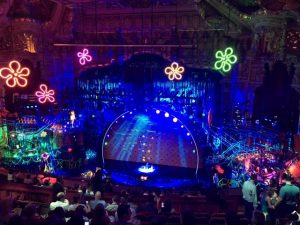SpongeBob SquarePants has become a staple of pop culture and a source of nostalgia for both children and adults. Quotes and images from the show are spread all over social media to memetic levels, and it continues to have merchandise of all kinds. As such, a Broadway musical of SpongeBob seems like an appropriate, profitable idea. At first, such an idea sounds ludicrous and childish. Onstage, however, SpongeBob Squarepants The Musical is, indeed, ludicrous and childish…in the best way possible. After a successful run in Chicago, playwright Kyle Jarrow and director Tina Landau have finally brought the spirit of the iconic cartoon to Broadway.
Right from the minute you walk in, you are transported to the atmosphere of Bikini Bottom thanks to the Palace Theater’s intensive set design. Not only is the stage decorated with an oceanic background projection (complete with small fish), but flowers and odd contraptions dangle around the stage, all to the tune of a pre-show jazz band. Even the walls of the theater far from the stage are covered with shimmering mylar curtains. Among all the glitz, Patchy the Pirate lingers and occasionally chats to a fan, before being comedically busted by security before the show begins. He returns in the beginning of Act 2 for a fun number lamenting oppression towards pirates. While the character’s Scottish accent sounds nothing like Tom Kenny’s take on the character, he still hypes the audience up appropriately before transitioning into the show, without feeling like much of a distraction.
The show itself has a standard plot concept: a volcano is about to wipe out all of Bikini Bottom, and SpongeBob, eager to prove his worth and disprove the pessimists, vows to save the city. Its moral of togetherness and optimism in the face of adversity is also pretty standard. However, a simple plot does not necessarily mean a simple play. Every major character has their own story arc, many highlighting the effects of a crisis on a community: a cult of sardines begins worshipping dim-witted Patrick, greedy Eugene Krabs exploits the town’s desperation to advertise his food, the evil Plankton and his wife aim to lure the citizens away from town and brainwash them, and everybody turns on one another. Some characters that don’t often get explored in the cartoon get explored in the show. Mr. Krabs’ teen daughter Pearl gets her own number belting about how her father cares more about money than her, and Plankton’s computer wife Karen is revamped from a snarky computer barely tolerating her husband to a woman slowly rediscovering the spark in her long marriage through mutual evil schemes.

Even Spongebob is not opposed to including some relevant political messages; the mayor (a character seemingly created for this show) lies about having the situation under control, the media’s nonstop talk about impending doom only feeds the frenzy, and the government and media blame each other. There is also a subplot of the fish scapegoating Sandy Cheeks simply for being a land mammal. While some of these conflicts could be seen as slightly forced, and the resolution to Sandy’s plot is a bit underwhelming, they fit the tone of the show and provide some emotional depth.
So much of the show is dedicated to comedy; barely a moment passes by when something hilariously ridiculous is not happening. Most of the humor is derived from wacky cartoony antics, which become wackier when translated to stage punctuated with silly sound effects. Just like the show famously was, the musical is aware of its nonsense style and manipulates it to keep the audience on their toes. It drops a few iconic references to the original show (such as “Is mayonnaise an instrument?”), but doesn’t become so reliant on them that it would confuse new fans. It may not be dripping with insight, but it has enough tension and heartwarming moments that the humor doesn’t become grating- if anything, the levity is refreshing in a world of “art has to be deep to be good”.
Like the set, the costume design for the show is impressive. Primary characters are given colorful but simplified translations of their cartoon equivalents, and while some may not be immediately recognizable as their characters (Pearl, Karen, and even Sandy for example), the actors’ mannerisms make it obvious. The best technical work for a costume definitely goes to Squidward, who has two extra prosthetic legs that bend opposite his real legs to replicate the four-legged stance of the anthropomorphic squid. Squidward’s dance numbers are even more captivating to see how well Gavin Lee adapts to his extra appendages. Background characters receive even more extravagant design choices akin to a neon Lady Gaga, some even playing sea monsters that are twice the height of a normal human. The costumes and set together develop the mysterious weirdness of Bikini Bottom flawlessly.
Many composers with various styles came together for SpongeBob, from Panic! At the Disco to Cyndi Lauper to the late David Bowie. Going into the show with this fact, I had no idea what to expect, and feared the music would be disjointed. Somehow, it tied together very well. Every song has that upbeat SpongeBob energy, even when the situation seems dire. The stage comes to life with every number: Plankton gets his own rap number and background dancers, neon sponges illustrate SpongeBob’s thoughts during his solo about not being a “simple” sponge, and a sad duet between SpongeBob and Patrick projects cartoon images of their friendship onto the stage.
SpongeBob The Musical is worth seeing even if you aren’t a young child or a very well-versed fan of the show. In a world that seems hopeless, SpongeBob provides boundless amounts of energy and a variety of effects that remind you what it feels like to be a kid again. It doesn’t want you to ever feel unhappy, and in that way, it’s sort of like the yellow sponge himself.


Leave a Reply